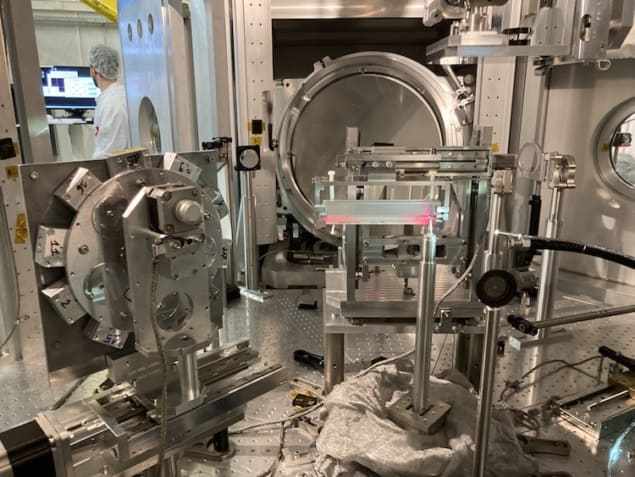Could lasers synthesize heavy elements produced in neutron-star mergers?
19 Mar 2024 Isabelle Dumé
The experimental campaign on the neutron generation at Apollon: The inside of the target chamber showing the off-axis parabola and some diagnostics. (Courtesy: Julien Fuchs)
An astrophysical process that creates elements heavier than iron may be even more challenging to reproduce in the laboratory than was previously believed – but not impossible. This is the conclusion of researchers at the Laboratoire pour l’Utilisation des Lasers Intenses (LULI) in France, who report that reproducing conditions typically seen during neutron-star mergers will require major improvements to both proton and neutron sources. This insight is crucial, they say, because it provides a more realistic framework for future efforts to replicate stellar processes.
Many heavier-than-iron elements form via the so-called r-process, where r refers to rapid neutron capture. This process occurs when two neutron stars merge, creating an abundance of free neutrons. In these neutron-rich environments, atomic nuclei capture neutrons much more quickly than they can lose them via beta decay (which occurs when a nucleus emits an energetic electron or positron, thereby transforming one of its neutrons into a proton).
Scientists believe that the r-process is the source of about half of all heavy elements found in the universe today. However, the exact conditions required to facilitate rapid neutron capture are not fully understood. This is because it is extremely difficult to generate the very high-density neutron fluxes needed to create neutron-rich isotopes in the laboratory.
A next-generation multi-petawatt laser system
The good news is that laser-driven (pulsed) neutron sources could produce the types of neutron beams required. In the approach developed by Vojtěch Horný and colleagues at the LULI, such a laser would first direct ultra-intense light pulses at a solid target. This would cause hydrogen ions from a contaminant layer on the target’s surface to accelerate to a significant fraction of the speed of light, Horný explains. These hydrogen ions would then be directed to a secondary target made of gold that would serve as both neutron converter and neutron capture target.
“Unlike the traditional method that accelerates deuterons [heavy hydrogen ions] for fusion reactions in a low-atomic-number converter (for example, one made from beryllium) to release neutrons, our approach leverages a new-generation multi-petawatt laser system to trigger a more efficient spallation process in high-atomic number materials,” Horný tells Physics World. “Here, protons accelerated to energies in the hundreds of megaelectronvolt (MeV) range strike a heavy nucleus, releasing a higher number of neutrons.”
Ways to enhance neutron production
Horný says that the goal of this method, which is described in Physical Review C, is to significantly enhance neutron production. Using numerical simulations, he and his colleagues calculated that currently-available lasers would produce a negligible number of neutron-rich isotopes (defined as those with at least two more neutrons than the initial seed nucleus).
However, a good isotope count would nevertheless be possible if the neutrons were slowed down to very low energies (20 millielectronvolts, corresponding to the temperature of solid hydrogen). Such slow speeds would boost the neutrons’ probability of being captured. The laser would also need to be pulsed at a frequency of 100 Hz for several hours.
Those are all tall orders, but Horný isn’t giving up. “Despite the sobering realization that current proton and neutron sources preclude the near-term observation of the r-process via laser-driven neutron sources, our work has laid important groundwork,” he says. There are also reasons to be hopeful about technological progress. As an example, Horný cites an ongoing project at Colorado State University in the US, where researchers are building two 200-Joule, 100-femtosecond, 100 Hz lasers. This project, he says, “represents a significant step forward”.READ MORE

The intense flux of neutrons the team described could have other applications, Horný adds. These include reconstructing a material’s elemental composition using fast neutron resonance radiography; fast neutron activation; and fast neutron therapy in medicine.
The LULI team is now preparing to fabricate their proposed laser source, with the hope of achieving record-breaking neutron parameters using the Apollon laser system. Horný, for his part, has moved to the Extreme Light Infrastructure-Nuclear Physics (ELI-NP) in Romania, where his work as a research scientist will focus on advancing electron and ion acceleration, as well as generating high-energy radiation from laser-plasma interactions. The new role, he says, involves exploring various sources of secondary particles, including neutrons.

Isabelle Dumé is a contributing editor to Physics World
FROM PHYSICSWORLD.COM 24/3/2024

Δεν υπάρχουν σχόλια:
Δημοσίευση σχολίου